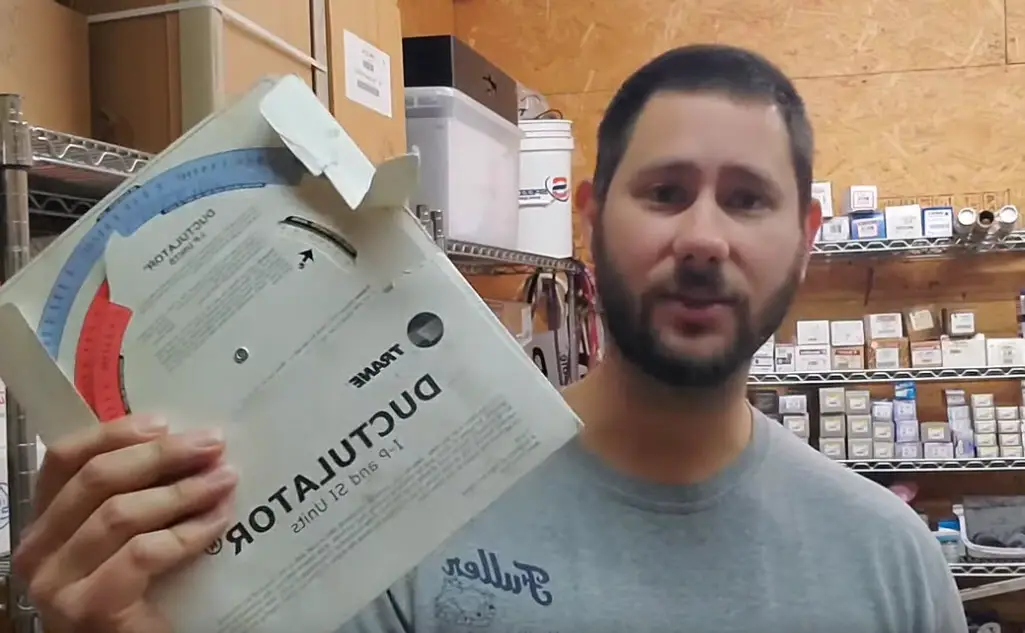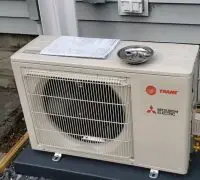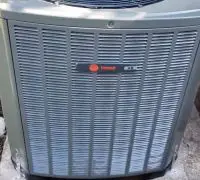Trane Ductulator is a helpful device when sizing the new air duct and understanding how to improve current ductwork. With a Trane Ductulator, you will be able to appreciate air loss, correctly size the ducts, determine the round or rectangular duct equivalent and identify velocity. When using a Trane ductulator, you will be able to reduce the risk of expensive errors. Field technicians, engineers, and skilled DIY-ers can use the Trane ductulator.
Page Table of Contents
What’s a Trane Ductulator?
Using the perfect size of ducts for a house is crucial for HVAC’s efficiency. It seems that delivered airflow into a home is under 65% of what’s needed. Poor airflow and incorrect duct sizing can also cause equipment issues, excessive total external static pressure (TESP), expensive callbacks, thermostat problems, discomfort, and high warranty spending.
Trane ductular helps designers size HVAC ducts without using a calculator. Initially, charts and tables would help them size the ducts. The ductulator was developed as the primary tool to size the duct in a house to improve productivity. The ductulator consists of air volume, velocity, round duct section, and rectangular dimension.
Like other ductulators, the Trane ductulator comes with a metric and imperial side. The placement of the sections is different between the two sizes, and, after some time, you will be able to know which units you work in.
How to use Trane ductulator?
Most of the time, you will take the following steps to use the ductulator:
- Decide the amount of air you move in CFM or L/S
- Choose the driver for the selection. It can be a pressure drop in inches per 100ft, or PA, or velocity (fpm or m/s)
There is a connection between velocity/pressure drop, duct size, and used energy. Typically, the higher the pressure drop, the smaller the duct size. However, the energy use will be higher.
Most designers use 0.8″/100ft for small volumes and keep the velocity between 1,800fpm and four fpm for high volumes. After you combine the two variables, you can continue with further readings.
Let’s get into the details!
Imagine water traveling through the house. It goes saying that more water will pass through a 3in diameter fireman hose than through a smaller garden hose. Additionally, the more water you push through, the faster and further the water will come out of the house.
It’s similar to air. It’s possible to push air through any space before issues develop. If there’s too much air pushed, you will encounter leakage, resistance, and static pressure problems.
Take a look at the cover of the ductulator and you will notice the typical recommendations for air velocity, air distribution system components, exhaust air outlet, the coil, etc. You will also see the formula to calculate speed. The white numbers are for round duct dimensions, whereas green is for rectangular duct dimensions.
Let’s say you have a rectangular 10x10in. Align the two numbers at the bottom and get the answer for duct sizing.
Check out the air quantity window to see how much air goes through the duct and how much resistance air you will encounter. You need to see the display of air quantity (CFM) inside the window. Below, you notice the duct’s friction loss (static pressure) per 100ft. The more resistance you have, the more energy the system will use to push the air.
To push 200CFM air through the duct, you will have 1,600 friction loss (little resistance). If you start with 200cfmp, the forced air through a 100ft duct, you will have the same amount of air on the other end (it depends on the obstacles).
When having to push 2,000CFM through the same duct, you will have higher resistance (1.2″ static pressure, respectively friction resistance). There will be tremendous air loss because of the air source’s high resistance and high energy spending.
Take a look at the velocity window. When you want, for instance, water to travel further, you adjust the nozzle. When you turn the nozzle, the opening becomes smaller and the speed of water increases. You don’t increase the quantity of water, but only the rate. When you increase the velocity, you reduce the amount of water or volume.
It’s the same with air. At 200CFM, you will remove air through 300CFM. At 2,000CFMP. There will be 3,000 cubic feet per minute and various issues: too much air noise and duct leakage.
Let’s use another example with a 300-tone unit. Each air tone is equal to 400CFM, so a 300 tone unit will push 1,200 CFM. You want your unit to introduce no more friction than 0.5 in static pressure, which is 0.5 on the friction loss chart. You need to align 0.5 to 1,200CFM, which gives 17 diameters for a round duct. You will get the best results with an 18in duct with standard sizing. For rectangular ducts, check out at the bottom. Ten aligns to 25, whereas 12 aligns, t0 20. Therefore, you will be able to use a 10×25 rectangular duct or a 12×40 one.
The Trane ductulator comes with many equations and formulas on the back. Each turn and angle affects the friction loss so that you can calculate resistance for every scenario.
What are the common mistakes when using a Trane ductulator?
As with anything in life, there are good and bad ways to use tools. Here are the most frequent mistakes when using a Trane ductulator:
Use it with flexible ducts
Unless you see it labeled on the ductulator made to use with flexible ducts, you cannot use it with sheet metal. You will encounter high static pressure and low airflow if you size flexible ducts with a sheet metal duct calculator.
It’s because the materials are nothing alike. Sheet metal is smooth and the flex has an uneven helix core. Flex ensures more resistance to airflow due to the spiraled surface and it’s not considered with a sheet metal ductulator. You will have to use a duct calculator specially made for flexible ducts.
Use the .10 friction rate too frequently
One of the many incorrect ductulator uses is consistently using the .10 friction rate to make a duct system. It’s widely spread as the most efficient setting for residential applications.
However, to place the friction rate number in context, the ideal residential setting on the duct calculator is made for 100ft of effective duct, not its actual length. Adequate feet refer to duct length and equivalent duct length of every fitting. The resulted length is often skipped and can profoundly affect design and performance.
Equivalent length resembles duct fitting to what its length would be when straight. Duct fitting with sharp turns will present a higher equal length than a fitting with smooth turns.
Not allowing internal duct liners
Many people forget that duct sizes should be based on internal duct dimensions. If skipped, the inner area could be smaller than planned, especially in the case of thick duct liner.
Discover liner thickness with a test. Install a test port in the duct and identify the depth gauge with a static pressure tip. Place the tip into the test port and pull until you sense the curved end of the static pressure tip compressing the liner. See the distance between the duct wall and the pressure tip’s magnet. Place the static pressure tip aside and measure the distance between the curved tip inside and the magnet. To identify the duct liner thickness, you need to subtract two measurements.
Measure airflow
Let’s say you measure a .06 in static pressure of the water column in a 24×10 plain metal duct. You use the ductulator and see you need a 24×10 duct size. You continue with locating the static pressure measurement on the friction rate per 100ft of duct line. You will consider the line intersection as airflow through the duct, 1200CFM.
To find airflow in a duct by pressure, you have to measure velocity pressure, not static pressure. You use a Pitot tube at several points in the duct to measure velocity pressure. You will use a traverse method and convert it to air velocity.








